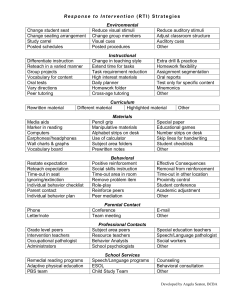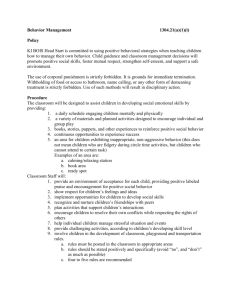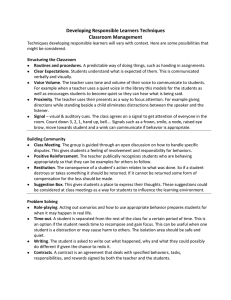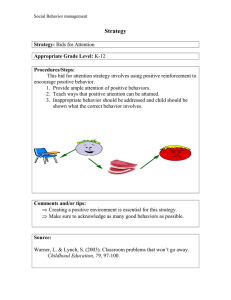Effective Classroom Management Strategies for Use During Small
advertisement
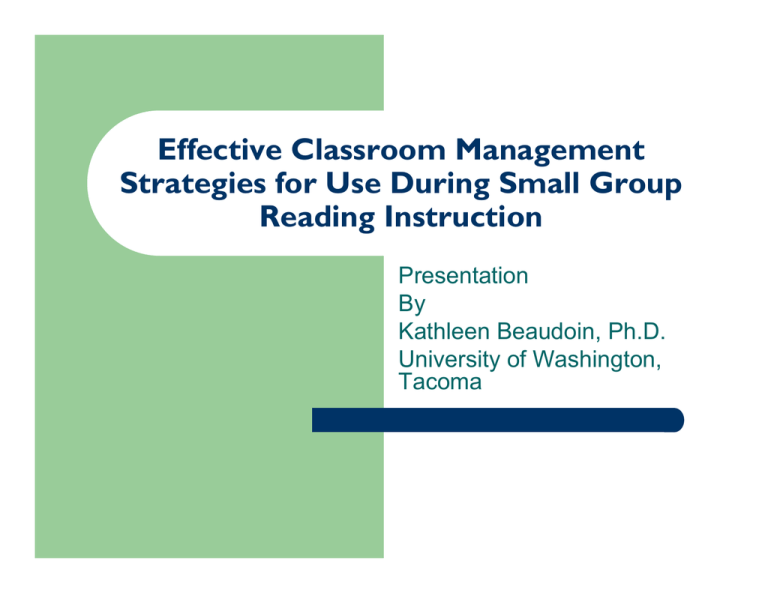
Effective Classroom Management Strategies for Use During Small Group Reading Instruction Presentation By Kathleen Beaudoin, Ph.D. University of Washington, Tacoma Frequently Cited Problem Behaviors z z z z z z z z Not following along* Blurting out responses* Disturbing others* (including making noises & deliberately annoying others) Delays in starting reading task Out of seat Not prepared with materials Non-Compliance Arguing Source: Survey of 48 elementary reading teachers *over 50% cited this problem as occurring at least frequently Effective Management z “… effective and ineffective teachers do not differ much with respect to how they handle discipline problems. Instead, they differ with respect to the number of discipline problems they encounter, the effective teachers having fewer problems. In operational terms, effective teachers are likely to focus on antecedent control and establish a structure such that problems are less likely to occur” Elliot, Witt, Kratochwill, & Stoiber, 2002. p. 244). Physical Structure z The goal is to design a structure that allows the teacher to interact quickly and easily with all students. – – – Respond consistently to minor misbehavior Respond to misbehavior before it escalates Engage frequently in positive interactions Physical Structure z Consider risk factors when determining arrangement. – – – – z z Grade level number of students reputation of class teacher experience Optimize for most common types of instructional tasks. If necessary, train students in procedures for physically restructuring the room. Source: Sprick, R. S., Garrison, M., & Howard, L. (1998). CHAMPs: A proactive and positive approach to classroom management. Eugene, OR: Pacific Northwest Publishing. Getting Started with Expectations for Behavior z z z z z Define expectations for group, independent & transition times. – 5 or fewer – Ex. hand raising times vs. free-talking times Teach Expectations. – Teach to mastery – Re-teach frequently Monitor Expectations. Encourage Compliance. Use Correction Procedures. Example: Expectations for Independent Seatwork z Independent Seatwork – – – – – Use level 1 voices. Work at your seat until assignment is complete. Raise your flag if you have a question, but continue to work. Place completed work on the corner of your desk. Read your book when finished with the assignment. Activity 1: List 3-5 expectations for each of the following activities. Small group Independent seatwork Transition times Teaching Expectations z z z z z z z Describe the expectations. Provide examples and non-examples. Rehearse the expectations. Provide frequent opportunities to follow expectations. Reinforce compliance. Use corrective procedures that teach expectations. Review expectations frequently. Small Group and Independent Seatwork: Points to Consider z z z z z Provide instructions for independent seatwork before small group work begins. Begin small group instruction only after independent seatwork is going smoothly. Build natural stopping points within the small group lesson. Praise on-task independent workers while teaching the small group lesson. Encourage rather than punish. Transitions: Points to Consider z z z z z z Prepare all materials in advance and place them where they will be used. Provide a signal to notify students of time remaining until transition. Gain student attention before transition occurs. Give instructions on how to make the transition and the expectations for behavior. Use positive reinforcement. Use corrective procedures Responding to Specific Problem Behaviors z z z Not following along* Blurting out responses* Disturbing others* (including making noises & deliberately annoying others) Activity 2: What behaviors get in the way of teaching? Responding to Problem Behavior: A Continuum of Strategies z z z z z z z Ensure the task is appropriate Attend to appropriate behaviors Reinforcement of others Gentle verbal reminders Proximity control Pre-correction Ignoring Pre-Correction 1. 2. 3. 4. 5. 6. 7. Identify context for the predictable behavior. Specify expected behavior. Modify the context. Conduct behavioral rehearsal. Provide strong reinforcement for expected behavior. Prompt expected behavior. Monitor the plan A Continuum of Strategies cont. z z z z z Verbal reprimands Quiet time Owing time Non exclusionary time-out Exclusionary time-out Third party sanctions z (Source: Mercer & Mercer, 1998) Verbal Reprimands z z z When reprimanding, tell the student what behavior is inappropriate and why. When delivering a verbal reprimand, position yourself close to the student and speak in a quiet but firm voice. Follow verbal reprimands with reinforcement. Quiet-Time Strategy Step 1. Require students to stop what they are doing immediately. Step 2. Require students to remain absolutely quiet. Step 3. Maintain quiet time for 1 or 2 minutes. Step 4. Remind students of rules and expectations for current task. Step 5. Have the students resume previous task. Step 6. Use reinforcement to maintain appropriate behavior. Owing-Time Strategy Step 1. Identify the behaviors/circumstances that will result in owing time. Step 2. Discuss situation with the offending student. Step 3. Determine how much time the student will owe. Step 4. Identify when students will owe time. Time-Out From Positive Reinforcement Step 1. Define the behaviors that will result in time-out being implemented. Step 2. Decide location of the time-out area. Step 3. Implement time-out procedure calmly. Step 4. Determine the length of the time-out period. Step 5. Require the student to make up any work missed during time-out. Step 6. When the student is out of the time-out area, reinforce appropriate behavior. Final Note About Punishment z Punish-based discipline does not improve school safety, learning or behavior. (Source: National Association of School Psychologists, 2002, Fair and Effective Discipline for All Students: Best Practice Strategies for Educators) Final Word About Reinforcement z “For the reinforcement to work, it has to be easier to get and be a better pay-off than the pay-off from the problem behavior”. Source: Center for Effective Collaboration and Practice, 2000. Addressing Student Problem Behavior-Part III: Creating Positive Behavioral Intervention Plans and Supports. http://cecp.air.org.
